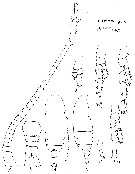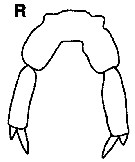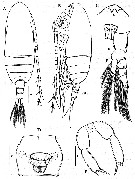|
|
 |
Fiche d'espèce de Copépode |
|
|
Calanoida ( Ordre ) |
|
|
|
Calanoidea ( Superfamille ) |
|
|
|
Paracalanidae ( Famille ) |
|
|
|
Parvocalanus ( Genre ) |
|
|
| |
Parvocalanus elegans Andronov, 1972 (F,M) | |
| | | | | | | Syn.: | Paracalanus dubia : Grice, 1962 (p.183, figs.F, Rem.);
Paracalanus elegans : Chihara & Murano, 1997 (p.845, Pl.134: F,M); Noda & al., 1998 (p.55, Table 3, occurrence); Shimode & Shirayama, 2004 (p.607, tab. 2); Ohtsuka & al., 2008 (p.115, Table 5); Fazeli & al., 2010 (p.153, Table 1); Saitoh & al., 2011 (p.85, Table 4, 5); Johan & al., 2012 (p.647, Table 1, 2, fig.2, salinity range); Johan & al., 2012 (2013) (p.1, Table 1); Nakajima & al., 2015 (p.19, Table 3: abundance); | | | | Ref.: | | | Andronov, 1972 (p.140, figs.F,M); Bradford, 1978 (p.133); Hiromi, 1981 (p.159, fig.F); Kesarkar & Anil, 2010 (Rem.: p.406); Al-Yamani & al., 2011 (p.28, figs.F); Soh & al., 2013 (p.70, figs.F); S.Y. Moon & al., 2014 (p.45: F) |  issued from : Andronov V.N. in Zool. Zh., 1972, 51 (1). [p.140, Fig.2]. Female (from 11°21N, 46°13E): 1-2, habitus (ventral and lateral, respectively); 3-7, P1 to P5; 8, rostrum; 10-11, genital segment (dorsal and left lateral side, respectively). Male: 9, rostrum; 12-15, P2 to P5; 16-17, habitus (dorsall and lateral, respectively
|
 issued from : J. Hiromi in Bull. Plankton Soc. Japan, 1981, 28 (2). [p.160, Fig.4]. Female (from Japan): a-b, habitus (dorsal and lateral, respectively); c-g, P1 to P5. Scale bars 0.100 mm.
|
 issued from : G.D. Grice in Fish. Bull. Fish and Wildl. Ser., 1962, 61. [p.184, Pl.4, Figs.4-12]. As Paracalanus dubiaFemale (from 00°38'N, 130°20'E): 4-5, habitus (dorsal and lateral, respectively); 6, urosome (dorsal); 7, A1; 8, P1; 9, P2; 10, P3; 11, P4; 12, P5.
|
 issued from : K.S. Kesarkar & A.C. Anil in J. mar. Biol. Ass. UK, 2010, 90 (2); [p.406, Table 2]. Characteristics of females.
|
 issued from : K.S. Kesarkar & A.C. Anil in J. mar. Biol. Ass. UK, 2010, 90 (2); [p.407, Fig.5, R]. Female:R, P5. [and not S indicated by error. C.R.]
|
 Issued from : H.Y. Soh, S.Y. Moon & J.H. Wi in Invertebrate Fauna of Korea (eds) Incheon: NIBR, 2013, 21 (28). [p.71, Fig.41]. Female (from Korean waters): A-B, habitus (dorsal and lateral, respectively); C, forehead with rostrum (ventral view); D, genital segment (ventral); F, P5. Scale bars: A, B = 100 µm; C-F = 25 µm.
|
 Issued from : V.N. Andronov in Russian Acad. Sci. P.P. Shirshov Inst. Oceanol. Atlantic Branch, Kaliningrad, 2014. [p.73, Fig.19: 14 ]. Parvocalanus elegans after Andronov, 1972 a. Male P5.
|
 Issued from : S. Y. Moon, S.-H. Youn & H.Y. Soh in ZooKeys, 2014, 456. [p.42, Table I]. Female : marphological characters. Compare with other species of Parvocalanus : ( P/ arabiensis, crassirostris, dubia, leei, latus, serratipes, scotti).
| | | | | Ref. compl.: | | | Madhupratap & Haridas, 1986 (p.105, tab.1); Othman & al., 1990 (p.561, 563, Table 1); Uysal & al., 2002 (p.17, tab.1); Rezai & al., 2004 (p.486, tab.2, 3, abundance, Rem.); Rezai & al., 2005 (p.157, Table 2, 5: spatial & temporal variations); Prusova & Smith, 2005 (p.75); Zenetos & al., 2005 (p.63, Rem.: p.82, casual occurrence); Cornils & al., 2010 (p.2076, Table 3, Fig.5, fig.F); Zenetos & al., 2010 (p.397); Chew & Chong, 2011 (p.127, Table 2, 3, abundance vs location) | | | | NZ: | 6 | | |
|
Carte de distribution de Parvocalanus elegans par zones géographiques
|
| | | | | | | | |  Carte de 1996 Carte de 1996 | |
| | | | Loc: | | | Medit. (Lebanon Basin) (in Uysal & al., 2002), G. of Aden, Gulf of Oman, Arabian Gulf (Kuwait), Perai River estuary, Straits of Malacca, Sangga estuary, Malaysia (Sarawak: Bintulu coast), Tioman Is., SW Celebes, Palau Is., N New Guinea,, Australia (G. of Carpentaria), Japan Sea, japan (Tanabe Bay), S Japan (Kuchinoerabu Is.), Korea | | | | N: | 21 | | | | Lg.: | | | (101) F: 0,49; (148) F: 0,51-0,457; (439) F: 0,5-0,48; (1085) F: 0,45-0,58; M: 0,4; (1174) F: 0,59-0,63; {F: 0,45-0,63; M: 0,40} | | | | Rem.: | épipélagique.
Lesseptian migration possible.
Voir aussi les remarques en anglais | | | Dernière mise à jour : 30/10/2019 | |
|
|
 Toute utilisation de ce site pour une publication sera mentionnée avec la référence suivante : Toute utilisation de ce site pour une publication sera mentionnée avec la référence suivante :
Razouls C., Desreumaux N., Kouwenberg J. et de Bovée F., 2005-2025. - Biodiversité des Copépodes planctoniques marins (morphologie, répartition géographique et données biologiques). Sorbonne Université, CNRS. Disponible sur http://copepodes.obs-banyuls.fr [Accédé le 02 janvier 2026] © copyright 2005-2025 Sorbonne Université, CNRS
|
|
 |
 |










